#global development delay
Explore tagged Tumblr posts
Text
Found some “this user is/has” photo collages and thought I’d make little post of a few of them that show my disabilities!! Made by @feelingthemode




If anyone wondering what my deformity/deformities are. They are knee valgus, leg length discrepancy, and deviated septum. The first two cause me moderate issues. While the last one causes moderate to severe issues because It makes breathing very difficult.
#developmental disabilities#i/dd#intellectual disability#global development delay#learning disability#deformity#hallux valgus#leg length discrepancy#deviated septum
8 notes
·
View notes
Text
What To Look For to See If Your Child Has GDD?
Skills development in children should begin at a certain age. For example, a newborn can start rolling over and performing similar motions about four or five months, possibly earlier or later.
However, if a baby is unable to move much after completing the stated milestone, is unable to hold up their head, or is still not "babbling," these may be the first indicators of a general developmental delay.
To compare your child's progress to average developmental milestones, complete the checklist below:
-By three to four months old, the newborn should be able to respond to loud stimuli. The child should be able to murmur and imitate sounds.
-Around seven months of age, the baby should begin to respond to sounds.
-At the age of one, the infant should begin uttering simple words like "mama".
-At age two, the infant should be able to say at least 15 words.
It should be able to communicate in brief, usually two-word sentences without mimicking or repeating others.
Instead of acting out their requests, the youngster should usually speak to convey them.
If your kid does not display these typical developmental changes, it is likely that he or she has a global developmental delay.
Tomatis® Australia offers global delay development treatment.
0 notes
Text
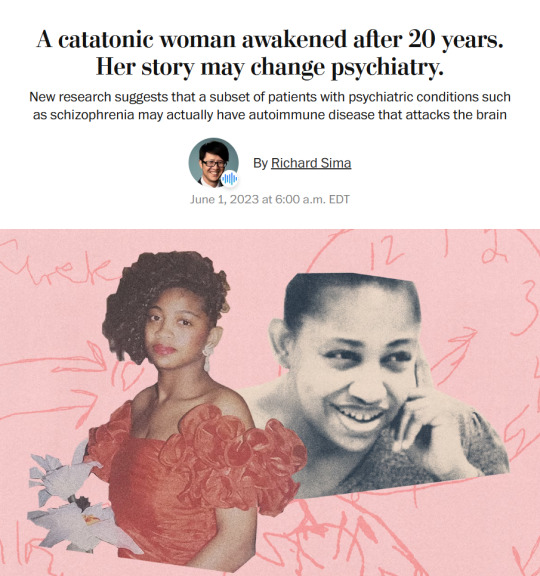
Story from the Washington Post here, non-paywall version here.
Washington Post stop blocking linksharing and shit challenge.
"The young woman was catatonic, stuck at the nurses’ station — unmoving, unblinking and unknowing of where or who she was.
Her name was April Burrell.
Before she became a patient, April had been an outgoing, straight-A student majoring in accounting at the University of Maryland Eastern Shore. But after a traumatic event when she was 21, April suddenly developed psychosis and became lost in a constant state of visual and auditory hallucinations. The former high school valedictorian could no longer communicate, bathe or take care of herself.
April was diagnosed with a severe form of schizophrenia, an often devastating mental illness that affects approximately 1 percent of the global population and can drastically impair how patients behave and perceive reality.
“She was the first person I ever saw as a patient,” said Sander Markx, director of precision psychiatry at Columbia University, who was still a medical student in 2000 when he first encountered April. “She is, to this day, the sickest patient I’ve ever seen.” ...
It would be nearly two decades before their paths crossed again. But in 2018, another chance encounter led to several medical discoveries...
Markx and his colleagues discovered that although April’s illness was clinically indistinguishable from schizophrenia, she also had lupus, an underlying and treatable autoimmune condition that was attacking her brain.
After months of targeted treatments [for lupus] — and more than two decades trapped in her mind — April woke up.
The awakening of April — and the successful treatment of other people with similar conditions — now stand to transform care for some of psychiatry’s sickest patients, many of whom are languishing in mental institutions.
Researchers working with the New York state mental health-care system have identified about 200 patients with autoimmune diseases, some institutionalized for years, who may be helped by the discovery.
And scientists around the world, including Germany and Britain, are conducting similar research, finding that underlying autoimmune and inflammatory processes may be more common in patients with a variety of psychiatric syndromes than previously believed.
Although the current research probably will help only a small subset of patients, the impact of the work is already beginning to reshape the practice of psychiatry and the way many cases of mental illness are diagnosed and treated.
“These are the forgotten souls,” said Markx. “We’re not just improving the lives of these people, but we’re bringing them back from a place that I didn’t think they could come back from.” ...
Waking up after two decades
The medical team set to work counteracting April’s rampaging immune system and started April on an intensive immunotherapy treatment for neuropsychiatric lupus...
The regimen is grueling, requiring a month-long break between each of the six rounds to allow the immune system to recover. But April started showing signs of improvement almost immediately...
A joyful reunion
“I’ve always wanted my sister to get back to who she was,” Guy Burrell said.
In 2020, April was deemed mentally competent to discharge herself from the psychiatric hospital where she had lived for nearly two decades, and she moved to a rehabilitation center...
Because of visiting restrictions related to covid, the family’s face-to-face reunion with April was delayed until last year. April’s brother, sister-in-law and their kids were finally able to visit her at a rehabilitation center, and the occasion was tearful and joyous.
“When she came in there, you would’ve thought she was a brand-new person,” Guy Burrell said. “She knew all of us, remembered different stuff from back when she was a child.” ...
The family felt as if they’d witnessed a miracle.
“She was hugging me, she was holding my hand,” Guy Burrell said. “You might as well have thrown a parade because we were so happy, because we hadn’t seen her like that in, like, forever.”
“It was like she came home,” Markx said. “We never thought that was possible.”
...After April’s unexpected recovery, the medical team put out an alert to the hospital system to identify any patients with antibody markers for autoimmune disease. A few months later, Anca Askanase, a rheumatologist and director of the Columbia Lupus Center,who had been on April’s treatment team, approached Markx. “I think we found our girl,” she said.
Bringing back Devine
When Devine Cruz was 9, she began to hear voices. At first, the voices fought with one another. But as she grew older, the voices would talk about her, [and over the years, things got worse].
For more than a decade, the young woman moved in and out of hospitals for treatment. Her symptoms included visual and auditory hallucinations, as well as delusions that prevented her from living a normal life.
Devine was eventually diagnosed with schizoaffective disorder, which can result in symptoms of both schizophrenia and bipolar disorder. She also was diagnosed with intellectual disability.
She was on a laundry list of drugs — two antipsychotic medications, lithium, clonazepam, Ativan and benztropine — that came with a litany of side effects but didn’t resolve all her symptoms...
She also had lupus, which she had been diagnosed with when she was about 14, although doctors had never made a connection between the disease and her mental health...
Last August, the medical team prescribed monthly immunosuppressive infusions of corticosteroids and chemotherapy drugs, a regime similar to what April had been given a few years prior. By October, there were already dramatic signs of improvement.
“She was like ‘Yeah, I gotta go,’” Markx said. “‘Like, I’ve been missing out.’”
After several treatments, Devine began developing awareness that the voices in her head were different from real voices, a sign that she was reconnecting with reality. She finished her sixth and final round of infusions in January.
In March, she was well enough to meet with a reporter. “I feel like I’m already better,” Devine said during a conversation in Markx’s office at the New York State Psychiatric Institute, where she was treated. “I feel myself being a person that I was supposed to be my whole entire life.” ...
Her recovery is remarkable for several reasons, her doctors said. The voices and visions have stopped. And she no longer meets the diagnostic criteria for either schizoaffective disorder or intellectual disability, Markx said...
Today, Devine lives with her mother and is leading a more active and engaged life. She helps her mother cook, goes to the grocery store and navigates public transportation to keep her appointments. She is even babysitting her siblings’ young children — listening to music, taking them to the park or watching “Frozen 2” — responsibilities her family never would have entrusted her with before her recovery.
Expanding the search for more patients
While it is likely that only a subset of people diagnosed with schizophrenia and psychotic disorders have an underlying autoimmune condition, Markx and other doctors believe there are probably many more patients whose psychiatric conditions are caused or exacerbated by autoimmune issues...
The cases of April and Devine also helped inspire the development of the SNF Center for Precision Psychiatry and Mental Health at Columbia, which was named for the Stavros Niarchos Foundation, which awarded it a $75 million grant in April. The goal of the center is to develop new treatments based on specific genetic and autoimmune causes of psychiatric illness, said Joseph Gogos, co-director of the SNF Center.
Markx said he has begun care and treatment on about 40 patients since the SNF Center opened. The SNF Center is working with the New York State Office of Mental Health, which oversees one of the largest public mental health systems in America, to conduct whole genome sequencing and autoimmunity screening on inpatients at long-term facilities.
For “the most disabled, the sickest of the sick, even if we can help just a small fraction of them, by doing these detailed analyses, that’s worth something,” said Thomas Smith, chief medical officer for the New York State Office of Mental Health. “You’re helping save someone’s life, get them out of the hospital, have them live in the community, go home.”
Discussions are underway to extend the search to the 20,000 outpatients in the New York state system as well. Serious psychiatric disorders, like schizophrenia, are more likely to be undertreated in underprivileged groups. And autoimmune disorders like lupus disproportionately affect women and people of color with more severity.
Changing psychiatric care
How many people ultimately will be helped by the research remains a subject of debate in the scientific community. But the research has spurred excitement about the potential to better understand what is going on in the brain during serious mental illness...
Emerging research has implicated inflammation and immunological dysfunction as potential players in a variety of neuropsychiatric conditions, including schizophrenia, depression and autism.
“It opens new treatment possibilities to patients that used to be treated very differently,” said Ludger Tebartz van Elst, a professor of psychiatry and psychotherapy at University Medical Clinic Freiburg in Germany.
In one study, published last year in Molecular Psychiatry, Tebartz van Elst and his colleagues identified 91 psychiatric patients with suspected autoimmune diseases, and reported that immunotherapies benefited the majority of them.
Belinda Lennox, head of the psychiatry department at the University of Oxford, is enrolling patients in clinical trials to test the effectiveness of immunotherapy for autoimmune psychosis patients.
As a result of the research, screenings for immunological markers in psychotic patients are already routine in Germany, where psychiatrists regularly collect samples from cerebrospinal fluid.
Markx is also doing similar screening with his patients. He believes highly sensitive and inexpensive blood tests to detect different antibodies should become part of the standard screening protocol for psychosis.
Also on the horizon: more targeted immunotherapy rather than current “sledgehammer approaches” that suppress the immune system on a broad level, said George Yancopoulos, the co-founder and president of the pharmaceutical company Regeneron.
“I think we’re at the dawn of a new era. This is just the beginning,” said Yancopoulos."
-via The Washington Post, June 1, 2023
#mental illness#schizophrenia#schizoaffective#psychotic disorders#psychology#neurology#autoimmune#autoimmine disease#neuroscience#medical news#medical research#catatonia#immunotherapy#immune system#clinical trials#good news#hope
6K notes
·
View notes
Text
While there is a great deal of similarity between Israel and Apartheid South Africa (down to the very close ties these countries shared), their strategies to delay inevitable collapse have turned out very different especially in terms of foreign policy. Like the South African government spent its last decade or so under Apartheid pursuing what Botha called his "Total Strategy", using every possible lever of influence to force the Frontline States into subservience; keeping them economically dependent on South Africa and politically acquiescent to Apartheid.
Military force was used for sure, but the only large scale deployments were the occupations of Namibia and southern Angola. Otherwise direct military action was restricted to commando raids, focused mainly on destroying infrastructure and carrying out political assassinations. South Africa instead preferred to act through local proxies, supporting (and often creating) various reactionary terrorist movements (i.e. UNITA in Angola, RENAMO in Mozambique, LLA in Lesotho) so that the destabilising effect of constant warfare would inhibit economic development, prevent unfriendly governments from taking any real action against apartheid and allow the offer of reduced terrorist support to be a bargaining chip in negotiations.
Economically South Africa used its control over transport infrastructure and large job market as both carrot and stick, rewarding compliant governments with better access to goods and increased migrant labour quotas (for many countries a vital source of income) while punishing disobedient nations with transport disruptions and reduced access to South African jobs. The specific mix of Military and Economic strategies would be tailored to suit the particular country at a particular time; for example South Africa's pressure on Angola was almost entirely military due to the lack of economic links between the two, while Swaziland's complete dependency made economics the primary South African approach. These different forms of pressure were also applied so as to compliment each other i.e. commandos and terrorist proxies would attack alternate railways and ports to ensure goods had to be transported through South Africa.
This was mainly done to extract political concessions. By 1980 the complete overthrow of unfriendly regimes was mostly off the table, so instead efforts were focused on changing the behaviour of the groups already in power. South Africa's main obsession was with the ANC boogeyman, constantly asking their neighbours to kick out ANC training camps and diplomatic ataches and forbid movement of ANC guerillas through their territory. However all manner of other demands were also made; economic integration, military access, opposition or at least neutrality towards UN sanctions etc. These were all attempts to drag the Frontline States back into South African dependency and under De Facto white Imperial rule; effectively undoing independence
In any case, as brutal as this "Total Strategy" was, it's a far cry from Israel's current approach which more resembles a genocidal temper tantrum. This is even in contrast to earlier Israeli strategies of coming to terms with neighbouring states and collaborationist movements; using Lebanon as an example they've gone from employing Christians Reactionaries as proxies to clumsily provoking the whole nation. There are structural reasons for this of course. South Africa needed it's black majority, both "at home" and in the neighboring states, as a reserve of cheap labour to extract cheap natural resources and buy globally uncompetitive manufactured goods. Indeed, the false independence of the "Bantustan" project was an attempt to remove South African citizenship from their entire black population and legally turn them all into migrant labourers. South Africa also has a much longer history as an independent Settler project, and while they recieved significant amounts of support from The West (especially the USA and doubly so under the more reactionary Presidents i.e. Ronald Reagan) this very much had its limitations; South Africa obviously couldn't wage a regional war of extermination even if wanted to. Meanwhile Israel's policy towards indigenous people is increasingly exterministic and there is no interest in maintaining their population; they even import migrant labourers from as far as Thailand to deny local Arabs. The country has also spent it's an entire existence as more or less a glorified NATO military base; they have more reason to favour a policy of genocidal war while hoping the US saves them from the consequences.
The point is that there are limits to how far you can take comparisons between South Africa and Israel. For all their similarities as Apartheid Settler States, were still different countries that occupied different contexts and so there are considerable socio-political differences between them that shouldn't just be ignored. You can't blandly use South African history to predict the course of Israel, or worse project current events in Israel onto a distorted version of South Africa's past. You won't develop a useful understanding of the world if you stick to broad assumptions and truisms; you need to actually investigate
278 notes
·
View notes
Text
The Best News of Last Week - 29 April 2024
1. Net neutrality rules restored by US agency
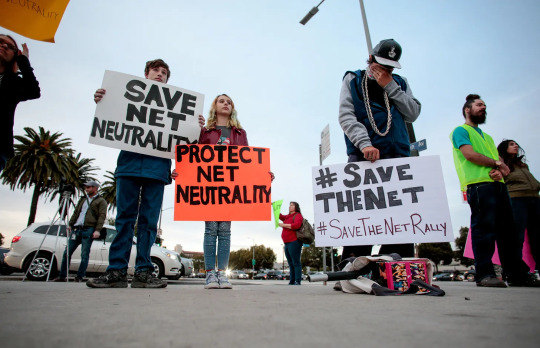
The U.S. Federal Communications Commission voted 3-2 on Thursday to reinstate landmark net neutrality rules and reassume regulatory oversight of broadband internet rescinded under former President Donald Trump.
2. Airlines required to refund passengers for canceled, delayed flights

DOT will also require airlines to give cash refunds if your bags are lost and not delivered within 12 hours.
The refunds must be issued within seven days, according to the new DOT rules, and must be in cash unless the passenger chooses another form of compensation. Airlines can no longer issue refunds in forms of vouchers or credits when consumers are entitled to receive cash.
3. How new mosquito nets averted 13 million malaria cases
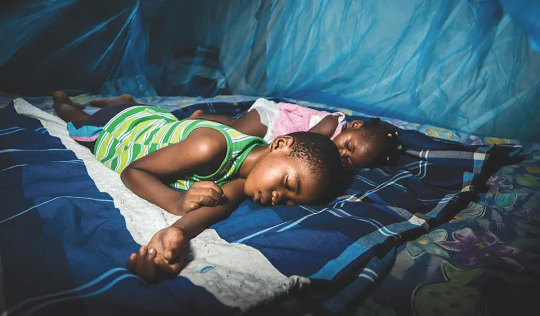
Compared to standard nets, the introduction of 56 million state-of-the-art mosquito nets in 17 countries across sub-Saharan Africa averted an estimated 13 million malaria cases and 24,600 deaths. The New Nets Project, an initiative funded by Unitaid and the Global Fund and led by the Innovative Vector Control Consortium (IVCC), piloted the use of dual-insecticide nets in malaria-endemic countries between 2019 and 2022 to address the growing threat of insecticide resistance.
4. Germany has installed over 400,000 ‘solar balconies’

This new wave of solar producers aren’t just getting cheap electricity, they’re also participating in the energy transition.
More than 400,000 plug-in solar systems have been installed in Germany, most of them taking up a seamless spot on people’s balconies.
5. Voyager-1 sends readable data again from deep space

The US space agency says its Voyager-1 probe is once again sending usable information back to Earth after months of spouting gibberish.
The 46-year-old Nasa spacecraft is humanity's most distant object.
6. Missing cat found after 5 years makes 2,000-km journey home
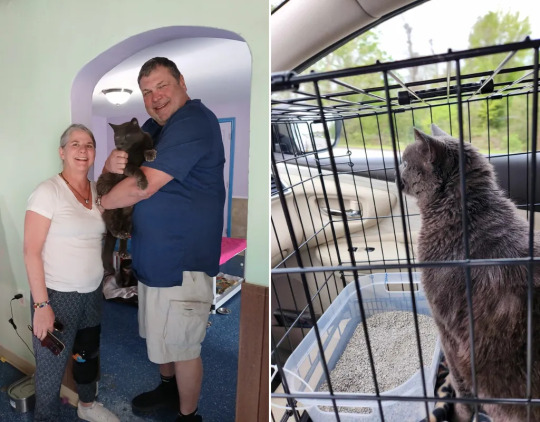
Five years after it ran out the door, a lost cat was returned to a couple in Nevada after it was found thousands of kilometres away. The couple are praising the cat’s microchip for helping reunite them.
7. Restoring sight is possible now with optogenetics
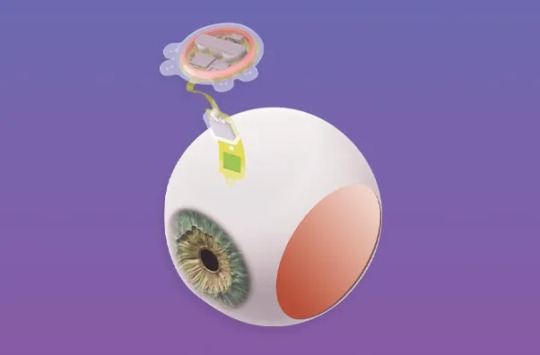
Max Hodak's startup, Science, is developing gene therapy solutions to restore vision for individuals with macular degeneration and similar conditions. The Science Eye utilizes optogenetics, injecting opsins into the eye to enhance light sensitivity in retinal cells.
Clinical trials and advancements in optogenetics are showing promising results, with the potential to significantly improve vision for those affected by retinal diseases.
---
That's it for this week :)
This newsletter will always be free. If you liked this post you can support me with a small kofi donation here:
Buy me a coffee ❤️
Also don’t forget to reblog this post with your friends.
652 notes
·
View notes
Text
(Image descriptions are in alt text due to taking up most of the post and making people less likely to read and reblog, a fully screen reader friendly version can be found here: https://www.tumblr.com/nightmaretour/761524737363099648/this-is-the-fully-screen-reader-friendly-version)

With everything going on, it's easy to miss that September is sepsis awareness month. As a sepsis survivor myself, I feel a great responsibility to spread awareness of this greatly underestimated killer, in hopes that this information might help some of you to save a life in the future.

Sepsis is a disease that affects around 49 million people worldwide every year, and responsible for around 20% of all global deaths, claiming approximately 11 million lives per year. It's estimated that one person dies of sepsis every 2.8 seconds. Around half of those who survive sepsis are left with physical or cognitive disabilities for the rest of their lives. On top of that, it's the most vulnerable of us that are most likely to develop sepsis.

Despite being one of the global leading causes of death, very few people know much about sepsis or how to spot it, which is what makes it all the more deadly. Sepsis kills approximately 1 in 6 people who contract it, but spotted early, patients with sepsis are around half as likely to die as those who have been allowed to develop into the later stages.
Sepsis is always the result of an existing bacterial, viral, fungal or even parasitic infection, usually due to a serious infection such as pneumonia or meningitis, but it can also be caused by something as small as an infected papercut or bug bite. Almost half of all cases occur in children.

But most importantly, it's all about time. If you or someone you know is experiencing any symptoms that you suspect might be sepsis, get to a hospital. It's far better to be wrong and live than it is to be wrong and die. I sincerely hope that you will never have to use this information, but if you do, I hope that it will help you to save a life.

Sepsis is incredibly time sensitive, even a few hours could be the difference between life and death. If you spot any of the signs in yourself or someone else, do not delay. Seek emergency treatment immediately.
For more information, visit:
Worldsepsisday.org
Globalsepsisalliance.org
Sepsisresearch.org.uk
Sepsis.org
243 notes
·
View notes
Text
Reverse 1999 and child soldiers (just rambling) (global friendly)
It doesn't take long for anyone to realise most of the cast (excluding awakened, entities like Voyager and AlienT, and people like Eternity) are young: ranging from most being 17-16 with adults around their 20s and Shamane currently being the oldest (excluding the above) at around 40. (Edit hes 45 thanks for clarifying)
Alright you say, this is a gacha game ofc the characters would be around these ranges and we hope every patch to get character that is above 40 (wdym someone like Tooth Fairy isn't 30? Same for Kakania and Isolde, how are they 19 and 18 respectively?For example). Hey I would like more older characters too, but I think the ages are partially intentional if we look into lore on a thematic level.
Ok. We already know the Foundation, Laplace and now Zeno (though it was ofc from Lilya) they produce child soldiers, workers and scientists:
Vertin is the Timekeeper at 12
Sonetto probably became a field investigator around 14-16 at best (correct me if we have a better frame of reference)
Ms Moission in her character profile apparently was a field investigator at 14. (I spelt her name wrong I think)
Mesmer Jr started working at the age of 12
As of the release of the Zeno anecdote we know Lilya around 14 was already in field missions and has seen the state of war.
(Probably could include X, Horrorpedia here but I don't have much info)
What am I getting at? Characters being young in their fields of work is completely intentional, one due to the Storm in the case of the Foundation as the first had taken nearly the entire workforce (plus Child Labour Laws) so in desperation to maintain numbers and order the age to become investigators, soldiers and scientists became much lower. I don't know if the SPDM existed before the Storm but the way it functions primarily serves to replenish those lost workforce.
And two: the perception of arcanists and the importance placed on the manifestation of their arcane skill as young as possible.
We see this in the case of Mesmer and Isolde/Trista.
Mesmer Jr once she was tested to see if she had her arcane skill immediately was set to manage mentally unstable patients at the age of 12. (She alongside Vertin probably needs the most therapy)
For Trista this was the seance her mother brought to at the age of 3, dying as a result and leading to her mother with Isolde to delay by 3 years. (Acting as if that was a mercy which it really is not)
There is an emphasis on an arcane families and arcanists maintaining their societal status/ relevance through children developing their arcane skills as soon as possible plus the idea of childhood and working is flipped on its head with the presence of arcanum.
Ok idk if worded that bit correctly but in short: our idea of when a child should be working (which is never) or the time someone should be in teaching before they get into a profession (TF, Kakania and Madam Z) is warped and absent in R1999. For Kakania, shes 19 but I would argue this is because of how she had dropped out and decided to be an unlicensed doctor. Most characters being younger is the result of arcanum being present in the world.
Moreover there is a general theme of lost childhoods/ forced to grow up fast in the younger cast. Exclude characters like Ezra, Matilda (so far) and Spathodea since they are relatively fine/ not deeply traumatised. Everyone else, Vertin, Sonetto, Mesmer Jr and characters like Eagle, Monlicht, Oliver Fog were forced to grow up fast despite their young age.
Summary: characters being in younger age ranges either being literal child soldiers or certain adults being relatively young is the result of the devastation of the Storm alongside the different perception of age in the arcanum world, there the manifestation of your arcane skill seems to be used as a sign of maturity and readiness to be thrown into work (Mesmer and Isolde being put om their respective career paths at a very early age) (or your Constantine celebrating the erasure of Child Labour Laws)
#reverse 1999#ramblings#r1999#vertin#analysis#vertin reverse 1999#isolde#idk to tag everyone here thats long lol#still i would like older characters than the i look 40 but actually 20 thing#idk if i explained properly here
159 notes
·
View notes
Text
Monday, July 3.
Nimona! *spoilers*
*WARNING! Major spoilers for Nimona follow.*
It's colorful, queer, and finally here. Trials and tribulations can make the victories all the sweeter, or so we are told. Only it seems there is some proverbial proof in the pudding: #nimona has finally made its way to Netflix after something of a bumpy ride, to put it lightly—and we are here for it. It's been a long time coming, too, with years and years spent in development hell.
Since its inception in June 2015, the film has survived a mega media merger between The Walt Disney Corporation and 20th Century Fox Animation (and delayed twice); in February 2021, one year before its projected release, Disney announced it was shutting down Blue Sky Studios, and production of the film was canceled entirely; it was then revived by Annapurna and Netflix; experienced several changes in creative leadership and a global pandemic (you may have heard of it) and a studio shutdown just as the film was finally coming together.
Now, the story that started life in ND Stevenson's beloved webcomic finally has made its way into silver screen heaven with its arrival on Netflix these past days. And it seems the dashboard's faultlessly loyal, long-time fandom can't get enough of this wild, wonderful, and life-affirming adaption.
#today on tumblr#nimona#nimona netflix#nimona film#ambrosius goldenloin#nimona comic#nimona spoilers#spoilers nimona#nimona spoiler#nimona movie#nd stevenson
1K notes
·
View notes
Text
“people only say i’m low support needs / high functioning autistic because i can speak 🙃” often followed by this is why functioning labels are BS or support needs labels are bad or why they are actually high support needs they just internalize it (while being able to perform bADLs and some iADLs independently on typical day, able to keep own safety, etc).
while able to verbally speak is not the only way to have significant support needs or be low functioning, being nonverbal not required to be high support needs (and also some nonverbal ppl aren’t high support needs),
being nonverbal or nonspeaking or minimally verbal is a significant thing that requires a lot of help, and it often doesn’t exist alone. as in, the people who say the quote above don’t realize nonverbal people are not “just like them but just can’t speak.”
being nonverbal/nonspeaking/minimally speaking/unreliably speaking (unreliable as in apraxia not as in lose speech) by itself is a thing that need significant attention to because need give extra! additional! support to gain functional communication. for most (if not all!) nonverbal nonspeaking people, functional communication is not guaranteed, it doesn’t develop naturally like most speaking people, either because of skills barrier, or external barrier like lack of resources, or both.
so, being nonverbal alone needs often intensive and long term intervention like speech therapy and AAC. even if you do everything right, give the most up to date affirming therapy, learning any AAC takes time, whether high tech or low tech. and they almost always require external help to reach their full communicative potential.
being able to functionally communicate (speech/sign/AAC, etc, but society put most emphasis on speech so you will have easier time if can speak) is such a fundamental part of our lives, it is severely limiting when you don’t have access to it. it inherently puts you at a disadvantage.
but being nonverbal often don’t exist alone.
being nonverbal means you have trouble with expressive language. sometimes that expressive language trouble is just you can’t speak.
but more often, there is more. like trouble communicating with more than one word at a time / multi word phrases / short broken sentences. or have small or basic vocabulary. difficulty remembering words. cannot grasp basic or complex grammar. have trouble find words. etc.
others may have extremely limited expressive language in all areas, even if you give them the best AAC and instructions, give them picture cards and photos, give them pen and paper, etc. yes, there are nonverbal people who may not be able to ever learn most or any form of AAC for it to be functional or reliable.
many nonverbal people may also have receptive language issues and have trouble understanding language. they may not understand the question being asked or the instructions given to them. they may only learn to read picture books with simple sentences, or not learn to read at all.
or, they also have intellectual disability, which affect everything not just language. they may be nonverbal because of their ID. they may struggle with everything above, and have trouble with problem solving, have trouble understand cause and consequence (not just rewards/punishment), difficulty remembering things, developmental delay, etc.
or, they have global apraxia (full body apraxia), or severe dyspraxia, which means they have trouble coordinate movements. they may have trouble dressing themselves, feeding themselves, physically follow directions, fine motor, gross motor, drooling, etc.
i have heard nonverbal people w severe full body apraxia describe it as a brain-body disconnect, their body have mind of its own. their mouth make noises they don’t want to make and cannot control, their body point to “yes” for a question when they mean “no” (so you can see how this impacts AAC use, yes?), their body running around when they just want to be still, etc.
it gets even tricky because! many of our understanding of intelligence and IQ tests require good enough motor skill. they assume that the way you act is the way you are internally. they assume you pointing to “no” when being asked “is the sky blue” if you genuinely not understand color, the sky, or language, not that your body pointed to the wrong thing.
many people w ID have poor motor skills. but many people w severe apraxia don’t have ID.
and this is just things i’ve seen in nonverbal autistic people. there are so many nonverbal people who are nonverbal because of brain damage, genetic disorders, and so on.
not to mention that being nonverbal and not having access to functional communication—not able to communicate what you want, don’t want, boundaries, socialize, etc. is a frustrating experience to say the least. having someone speak over you, make every decision for you, assume you can’t understand (whether you can or not), not even bother speaking to you, talking about you in front of you, etc. and when nothing else works, and you are frustrated and in overload, you meltdown, you “act out” to try to regain control or get others to listen to you, or you act out bc “other people say these things about me that’s not true so i might as well make it true.” then you get labeled with having behavior issues!
so yes, while it’s ignorant for people to dismiss speaking autistics just because they can speak, which is an issue that needs to be addressed, the way many low support needs speaking autistic talk about it is also ignorant.
#originally wanted to go in one direction but ended up going a different one instead??#sorry if the beginning doesn’t really correspond w the rest#actually autistic#actuallyautistic#actually nonverbal#nonverbal#nonspeaking#autism#autistic#🍞.txt
598 notes
·
View notes
Note
Hey, weird question, but what's it like being nonverbal/unreliably speaking?
Please understand I am simply asking out of genuine curiosity, and mean nothing bad with this ask. (Also, the fact that i have to specify that says stuff about the state of the internet, i suppose)
When Kiku was younger, before had access to communication aids, It was really hard. Especially because people thought Kiku was fully speaking and they didn't know much about autism or anything like that and Kiku wasn't diagnosed with anything (except possibly global development delays, not sure). Kiku couldn't communicate everything Kiku wanted or needed to. Didn't have words for it. And people thought what Kiku said was what Kiku meant and generally if Kiku was disregulated it wasn't what Kiku meant. Kiku couldn't tell was in pain, explain things that happened. Used Echolalia but got told repeating equals mocking so got in trouble for immediate echolalia. But a lot of Kiku's vocabulary feels like Kiku put together the words of other people. Just bits of different phrases and words from various media.
Being nonspeaking/unreliably speaking let to a lot of problems when Kiku was younger, because none of us knew and the things that came out of Kiku's mouth made people mad.
But now that Kiku knows and has communication aids it's not nearly as hard. Still hard. But not as hard. Kiku still has trouble communicating some things and processes things slowly.
For Kiku it's almost like English isn't Kiku's first language (even though it is). Although that might be the aphasia rather than anything else.
Kiku's mouth words are 90% of the time unreliable, especially if they aren't echolalia. That can range from "that's not what I wanted to say at all" to "that wasn't how I wanted to say that". And if it's not unreliable speech from apraxia then it's words being in the wrong order or the wrong word coming out of Kiku's mouth instead (usually always a similar word. Like couch instead of chair or taste instead of smell) because of aphasia.
If have any more questions feel free to ask ☺️
#kiku squeaks#special interest#autism#actually autistic#autistic#nonverbal#nonspeaking#aac user#apraxia#dyspraxia
85 notes
·
View notes
Text
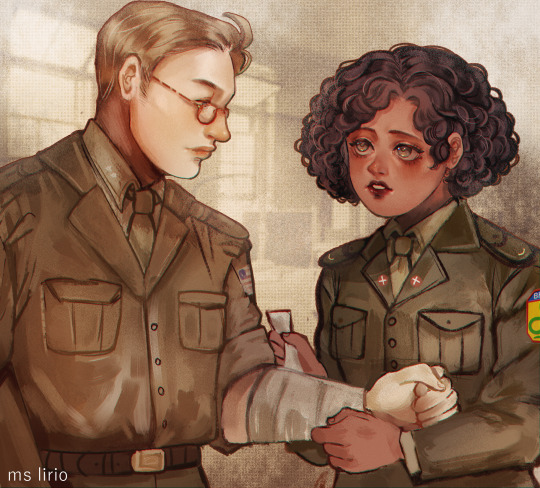
"You hurted yourself. Again."
"I guess I should say: I am deeply sorry."
"Do not act so reckless, Alfred."
"—Promise. And you should take a rest, you look tired."
"I am fine. Do not worry about me."

I have MANY pending books to read, whether diaries, reports, story books, Brazilian Pracinhas and Nurses and much more. But to save time, I decided to just read a few quick articles to prepare this post.
All pointed here is in a historical view.
Brazil was officially the only South American country to send troops to the conflict under its flag.
Historically, Brazil's actions prevailed in Italy. It was where Brazil sent its troops, and its participation in the war was delayed as Brazil wanted to maintain its relations with both sides and remain neutral throughout the conflict. After German and Italian attacks suffered by Brazilian ships, Brazil gave up its neutrality, siding with the Allies.
American military bases were built in the Northeast region of Brazil and Brazilian troops received American training.
"In 1939, with the beginning of the Second World War, Brazil remained neutral, in continuation of President Getúlio Vargas' policy of not defining itself by any of the great powers, only trying to take advantage of the advantages offered by them. Such "pragmatism " was interrupted at the beginning of 1942, when the United States and the Brazilian government agreed to transfer air bases on the island of Fernando de Noronha and along the north-northeast Brazilian coast to receive American military bases (if negotiations had not result, with Vargas and the military insisting on maintaining neutrality, the US had plans to invade the Brazilian northeast, codenamed Plan Rubber).” (WIKIPEDIA)
"Natal, the capital of the state of Rio Grande do Norte, in northeastern Brazil, has a very important strategic global geographic position. This fact made the city host the two main American military bases during the Second World War: the Naval Base and Parnamirim Field – at the time it was the largest US Air Force base on foreign territory.” (WIKIPEDIA)
// Getúlio Vargas flirted with the Fascist ideology even tho, he went to ALLIES' side. 💀
HCs: (don't take them too seriously)
⚠️ Remembering the following content: we are still talking about Hetalia, so my HCs and lore are not absolute truth, but my perception of my oc's participation during the conflict. Even though it has a historical basis behind it. And also, this is historical fiction (ofc, it's hetalia). WWII is an extremely sensitive topic to many. I ask for caution, I will be careful with what I have to say.
— Alfred used his charm and charisma to make Mayara fight alongside him (Good Neighbor Policy). What worked and they formed an alliance based on a mutual exchange of interests.
— Mayara had developed a strange feeling that intensified for Alfred (something between admiration and wanting to be like him, a complex feeling, which perhaps was confused with platonic love and which sought certain privileges in that alliance), even if she was reluctant to give end her neutral stance towards the conflict (something similar to what happened in WWI). She would later do this after torpedoing of vessels by German and Italian submarines, retaliation due to Brazil's accession to the Atlantic Charter; thus, she broke ties with the AXIS and declared war on Italy and Germany.
— In my universe, Mayara also served as a nurse, and spent most of her time with Alfred, often tending to his wounds. Sometimes just chitchatting together or learning about militarism and things like that. He trained her. He was the one who supported her.
— I changed my conception of another topic, which was May's direct participation on the battlefield. I think that Mayara, in addition to serving as a nurse, also fought on the front line when necessary (due to the fact that she was the representative of Brazil) and needed to be on the front line. In my former HC she didn't go to the front. (I disagree with the 2021 me xd).
— I don't believe that Alfred reciprocated any kind of feelings for May. She was an important piece for him, and so he courted her, to secure a new ally. It was a benefits relationship.
— Besides Alfred. There were FEW times where dialogues with England took place, this was due to the participation of Anglo-Brazilians on the English side (if I'm not wrong, in the area of aviation, but I need to delve deeper into the topic). An almost tiny interaction compared to the prevalence of Alfred's actions, which was immensely greater and also generated impacts.
PS: I don't ship BrAme/AmeBra, they are just friends. However, Mayara, as I said, had strange feelings for him at some moments in history (I was reading an article about diplomacy 🇧🇷-🇺🇸, I realized that Brazil had a greater interest in getting closer to the USA for economic and regional power, that is, an admiration that aimed for benefits/just as the US aimed for strategic support/Mayara would support Alfred in anything, as she thought she would get support in return).
I used the word "courtship" as it was stated in this old History book (which I no longer have). Alfred... used his charm against May. Lol.

Evidence of a strange obsession with Alfred:
Meet the United States of Brazil:

(I showed this damn flag to my dad he got disgusted lmfao)
#aph brazil#hetalia brazil#aph oc#country oc#country personification#hetalia#hws oc#aph brasil#hws america#aph america#alfred f jones#historical hetalia#hws usa
67 notes
·
View notes
Text
Are Children Who Have A Global Developmental Delay Still Go To School?
As some of you may already know, "global developmental delay," or "GDD," simply refers to the delays caused by conditions like autism, dyslexia, and other difficulties.
However, some parents worry that their child won't be able to attend school if they find out their child has such impairments.
The reality is that GDD is not a reason to prevent a child from having a good education. Australia's Disability Standards for Education were actually created for this reason. Almost all schools in the nation offer special education services in one way or another.
Nevertheless, there will inevitably be instances when applying these principles can be challenging. Parents should undoubtedly go above and beyond to ensure their special needs child is properly prepared for school.

Here are some excellent recommendations:
Make contact with the school of your choice.
It is still only proper to create a strong communication channel with the school your child will be attending, despite all the government regulations. Parents should become used to having their method of contacting a school, whether it involves speaking with teachers face-to-face or, at the very least, drafting a letter outlining their child's situation.
Obtain the diagnosis's relevant supporting paperwork.
While delivering the news in person is customary, there is nothing to restrict parents from asking for written confirmation of the diagnosis. These comprise test results and comprehensive reports that can be used as written documentation when requesting a spot in your preferred school's special needs program.
Interested in learning more about global delay development treatment? Visit us for a consultation right away!
0 notes
Text
Calling Long-Distance: 10 Stellar Moments in 2022 for Space Communications and Navigation
Just like your phone needs Wi-Fi or data services to text or call – NASA spacecraft need communication services.
Giant antennas on Earth and a fleet of satellites in space enable missions to send data and images back to our home planet and keep us in touch with our astronauts in space. Using this data, scientists and engineers can make discoveries about Earth, the solar system, and beyond. The antennas and satellites make up our space communications networks: the Near Space Network and Deep Space Network.
Check out the top ten moments from our space comm community:

1. Space communication networks helped the Artemis I mission on its historic journey to the Moon. From the launch pad to the Moon and back, the Near Space Network and Deep Space Network worked hand-in-hand to seamlessly support Artemis I. These networks let mission controllers send commands up to the spacecraft and receive important spacecraft health data, as well as incredible images of the Moon and Earth.
The Pathfinder Technology Demonstration 3 spacecraft with hosted TeraByte InfraRed Delivery (TBIRD) payload communicating with laser links down to Earth. Credit: NASA/Ames Research Center
2. Spacecraft can range in size – from the size of a bus to the size of a cereal box. In May 2022, we launched a record-breaking communication system the size of a tissue box. TBIRD showcases the benefits of a laser communications system, which uses infrared light waves rather than radio waves to communicate more data at once. Just like we have upgraded from 3G to 4G to 5G on our phones, we are upgrading its space communications capabilities by implementing laser comms!

3. The Deep Space Network added a new 34-meter (111-foot) antenna to continue supporting science and exploration missions investigating our solar system and beyond. Deep Space Station 53 went online in February 2022 at our Madrid Deep Space Communications Complex. It is the fourth of six antennas being added to expand the network’s capacity.

4. You’ve probably seen in the news that there are a lot of companies working on space capabilities. The Near Space Network is embracing the aerospace community’s innovative work and seeking out multiple partnerships. In 2022, we met with over 300 companies in hopes of beginning new collaborative efforts and increasing savings.

5. Similar to TBIRD, we're developing laser comms for the International Space Station. The terminal will show the benefits of laser comms while using a new networking technique called High Delay/Disruption Tolerant Networking that routes data four times faster than current systems. This year, engineers tested and proved the capability in a lab.

6. In 2021, we launched the James Webb Space Telescope, a state-of-the-art observatory to take pictures of our universe. This year, the Deep Space Network received the revolutionary first images of our solar system from Webb. The telescope communicates with the network’s massive antennas at three global complexes in Canberra, Australia; Madrid, Spain; and Goldstone, California.
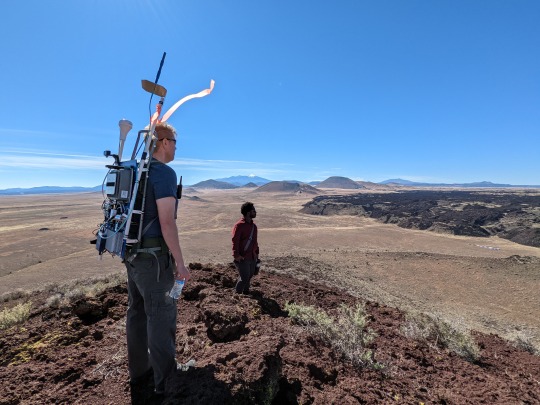
7. Just like we use data services on our phone to communicate, we'll do the same with future rovers and astronauts exploring the Moon. In 2022, the Lunar LTE Studies project, or LunarLiTES, team conducted two weeks of testing in the harsh depths of the Arizona desert, where groundbreaking 4G LTE communications data was captured in an environment similar to the lunar South Pole. We're using this information to determine the best way to use 4G and 5G networking on the Moon.

8. A new Near Space Network antenna site was unveiled in Matjiesfontein, South Africa. NASA and the South African Space Agency celebrated a ground-breaking at the site of a new comms antenna that will support future Artemis Moon missions. Three ground stations located strategically across the globe will provide direct-to-Earth communication and navigation capabilities for lunar missions.

9. Quantum science aims to better understand the world around us through the study of extremely small particles. April 14, 2022, marked the first official World Quantum Day celebration, and we participated alongside other federal agencies and the National Quantum Coordination Office. From atomic clocks to optimizing laser communications, quantum science promises to greatly improve our advances in science, exploration, and technology.

10. We intentionally crashed a spacecraft into an asteroid to test technology that could one day be used to defend Earth from asteroids. The Double Asteroid Redirection Test, or DART, mission successfully collided with the asteroid Dimorphos at a rate of 4 miles per second (6.1 kilometers per second), with real-time video enabled by the Deep Space Network. Alongside communications and navigation support, the global network also supports planetary defense by tracking near-Earth objects.
We look forward to many more special moments connecting Earth to space in the coming year.
Make sure to follow us on Tumblr for your regular dose of space!
1K notes
·
View notes
Text
Erin In The Morning:
In a groundbreaking development for the care of transgender youth in France, the French Society of Pediatric Endocrinology and Diabetology has released what is being called the first French national medical consensus on trans youth care. The document’s release comes as a variety of other countries consider the politically-influenced guidelines from the Cass Review in the United Kingdom, which has since been heavily criticized and its recommendations rejected by multiple medical societies in other countries. Importantly, the new guidelines recommend transgender youth care, denounce a “wait-and-see” approach for transgender adolescents, and promote individualized care for every transgender patient.
The guidelines, described as both robust and extensive, were meticulously prepared. According to the document, one to three authors were assigned to each section, conducting comprehensive literature reviews. Their findings were then refined through multiple iterations, with input from the broader group until a consensus was achieved. Finally, the recommendations underwent review by external experts. The result is a thorough and authoritative set of guidelines aimed at providing clear direction for doctors caring for transgender youth in France. The guidelines encompass a wide range of care recommendations for transgender youth, offering official support for puberty blockers and gender-affirming hormone therapy. Regarding puberty blockers, the guidelines emphasize their role in allowing transgender youth to explore their gender identity without the added distress of undergoing puberty, while also reducing the need for future surgeries. For hormone therapy, the recommendations advocate its use for transgender youth who meet the criteria outlined in the ICD-11, ensuring an individualized and evidence-based approach to care.
The recommendations strongly oppose the “wait-and-see” approach for transgender adolescents, often referred to as “gender exploratory therapy.” This practice, considered a form of conversion therapy, seeks to attribute a transgender person’s identity to external factors rather than recognizing it as authentic, delaying access to care—often until adulthood. The guidelines reject this method, stating it “does not reduce psychological distress” and instead “increases the risk of committing suicide and can affect psycho-affective and cognitive development.” These findings align with a report from the U.S. Centers for Disease Control showing that 25% of transgender youth in the United States have attempted suicide, alongside another study in Nature Human Behavior indicating that anti-trans laws, including healthcare bans, have caused up to a 72% increase in suicide attempts.
[...] These guidelines are poised to resonate both in France and globally. As countries and major medical associations increasingly distance themselves from the U.K.’s Cass Review—criticized for its connections to SPLC-designated hate groups—the scientific consensus continues to affirm the importance of gender-affirming care for transgender youth. Their release comes just one day before the U.S. Supreme Court hears oral arguments on healthcare bans targeting transgender youth across the United States. In a climate where medical care for trans youth is under relentless political attack, guidelines like these offer a beacon of evidence-based practice and will be instrumental in shaping a future where access to essential care is protected and secured for all.
Unlike much of the world, especially the UK ([cough]Cass Review[/cough]) and red states in the US, France has introduced guidelines on gender-affirming care that affirmatively recommend the practice.
30 notes
·
View notes
Text
Greedfall 2 Developers Are Going on Strike, Allege Studio Management Treats Workers Like ‘Galley Slaves’
The developers of upcoming fantasy role-playing game Greedfall 2 have announced plans to strike in protest of management just a few weeks before the game comes out.
Paris-based studio Spiders, which also developed Steelrising and The Technomancer, published an open letter signed by 44 of the 95 staff to studio management including CEO Anne Devouassoux. Spiders is wholly owned by publisher Nacon, which IGN has asked for comment.
The open letter details “several years of known problems, which have been greatly amplified over the past year with the arrival of the current head of the company: instability, opposition to anticipating problems and securing working conditions, global mismanagement, turnover and recruitment problems, unacceptable delays in achieving gender equality and parity, important lack of transparency, denial of problems, refusal to acknowledge worker representation and blocked negotiations.”
Specifically on Greedfall 2, workers allege it has suffered a “difficult” production and there is “widespread anxiety and a loss of interest among employees.” The staff also said they have suffered significant crunch working on the game.
“For many, it translates into a fear of releasing a disappointing game at the end and/or a feeling of shame over their own work,” the workers said. “For some, it's the last straw that pushes them to look for work elsewhere.”
Elsewhere in the document, the workers claimed that Greedfall 2's budget “was reworked multiple times and its early access release postponed several times.”
“Management gives the impression of treating us like galley slaves in the hold of a ship, rowing on and on without ever knowing either the route or the destination of their journey,” the workers said. “Spiders feels like a ship sailing with no one at the helm.”
Greedfall 2 currently has an early access release date of September 24, 2024, with a plan to release the game in full less than a year later. According to staff, that seems unlikely.
“The early access release is painful, as attested by the several delays it suffered, and the complete release of the game less than a year later seems difficult to achieve, as there is so much left to do,” they said.
The staff published a list of demands and outlined a plan to strike the week of September 2. Pickets will be held in front of the company’s offices and online on a Minecraft server created for the occasion, the staff said.
The Spiders strike comes amid a growing labor movement within the video game industry as workers seek to protect themselves from mass layoffs and the threats posed by AI. In July, Starfield developer Bethesda Game Studios became the first Microsoft studio to fully unionize under the Communication Workers of America, forming a "wall-to-wall" union of developers including artists, engineers, programmers, and designers. Sega of America's union ratified a contract earlier this year, with Activision's QA workers announcing a union of their own.
35 notes
·
View notes
Text
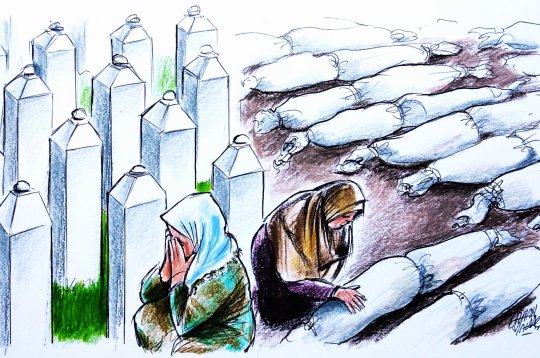
"Today, in this upside-down world, we feverishly await the final vote in the U.N. General Assembly on the genocide in Srebrenica, while Gaza has been destroyed, and its people starved and denied water." (Illustration by Erhan Yalvaç)
Of villains, heroes and the final act
Of villains, heroes and the final act | Opinion (archive.org)
BY FARHAN MUJAHID CHAK - MAY 14, 2024
A UNGA resolution condemning the Srebrenica genocide is developed by countries like Germany and the U.S., despite their complicity in the ongoing genocide in Gaza by supporting Israel
Ino longer believe in fairy tales, although I once did.
Raised with ideals of sacredness in life, I was taught to honor the sanctity of humanity, to champion international law, and to cherish freedom of speech as the cornerstone of societal progress. I believe the Geneva Conventions were a manifestation of our collective conscience that mandated the rules of war and held nations to account. Women and children; hospitals and schools; the elderly and infirm were inviolable. I was taught that "peaceful protest" was the quintessential liberty of a sophisticated society that understood the relationship between civic activism, social change and progress. I listened, attentively, to the lofty rhetoric and was enthralled. I would utter high-sounding words on democracy, equality and freedom, and those grand glutinous words stuck to my teeth. I was – in a way, smitten.
Head-over-heels over values that deeply resonated in me, yet I slowly became disillusioned. It became evident those hollow words were never meant to be believed, only used to establish authority and reproach others with their inhumanity. Justice was not blind, and race, color and creed mattered in the application of the law. It is in this troubled context that the United Nations General Assembly (UNGA) will vote on whether to declare July 11 "The International Day of Reflection and Remembrance of the 1995 Srebrenica Genocide." The complex intersection of the ongoing genocide in Palestine, the war on students and free speech on university campuses across the United States, Canada and Europe, and the former genocide in Srebrenica deserves closer scrutiny. The U.N. vote on the Bosnian genocide could not come at a more condemnable moment in world history.
On May 1, after considerable delay, a draft U.N. resolution on the Srebrenica genocide was submitted to the president of the 193-member U.N. General Assembly. Recall that in 1995, the town of Srebrenica was a U.N.-declared safe zone promised protection by a U.N. Dutch force. Dozens of able-bodied Muslim men in the town were asked to disarm, which they did. Despite that, fanatical Serb forces overran the safe zone and murdered 8,372 Muslim men and boys. Such is the perverse reality of the world we live in, that a U.N.-mandated safe haven, supposedly protected by U.N. forces, was invaded by terrorist Serb forces and a genocide ensued under their watch.
Bizarre irony
Now, a UNGA resolution on the Srebrenica genocide, partially modeled on a similar resolution for Rwanda, has been developed by several countries including Germany and the U.S. Absurdly, both are collaborators in the genocide currently underway in Gaza by direct military, economic and diplomatic support for Israel. This is the bizarre irony of being complicit in an ongoing genocide and putting forth a U.N. Resolution condemning the same.
What is the point of passing a resolution on genocide and turning a blind eye to one going on for the whole world to see? Sadly, villains need masks and no better cover than virtue. It is politics, not ethics, that is driving the U.N. Srebrenica vote. Of course, this does not diminish the necessity of it or the need to condemn the Srebrenica genocide and its denial. Still, the larger macro-level betrayal of the Geneva Conventions and International Human Rights Law by the U.S., U.K. and Germany is an indictment of the Western-led global order.
It is that outright duplicity, the sheer savagery of the genocide in Palestine, and the silencing of dissent that has provoked a whole generation of young people on campuses throughout the West. After all, they, too, were told stories about diversity, inclusion and pluralism. They were taught to condemn discrimination based on ethnicity, religion or gender. About equality before the law and the inviolability of non-combatants. They were raised to feel empowered and encouraged to peacefully organize and express their opinions. And, that society benefits when individuals exercise their civic duty. Now, they are witness to the flagrant disavowal of the moral archetypes that were instilled in them. They feel duped and are protesting, as heroes do, the enabling of genocide by their universities. Idealistic and courageous, they are sacrificing their education and careers to condemn the genocide in Palestine. Except rather than being celebrated, thousands of students have been beaten, harassed and arrested. Condemned for believing in the values that they were taught.
Now, we seem to be in the final act. One of impunity – if you will, in which we close our eyes to the genocide in Palestine, condemn students who protest it, and negotiate ways to commemorate a past genocide in Srebrenica – when ignoring it while it happened. Today, in this upside-down world, we feverishly await the final vote in the UNGA on the genocide in Srebrenica, while Gaza has been destroyed, and its people starved and denied water.
Yet, no matter the outcome of the resolution, it will not stop future genocides. Still, if nothing else, it will forever be a testament to the twisted dystopian reality in which we live and be a symbol of the urgent need for a new world order. Maybe, one faraway day, we can muster the will – for whatever purpose, and pass a U.N. resolution condemning it. Or name a highway after the martyrs. We will tell noble stories about those who were killed since it seems our twisted world only after their death feigns to honor them.
ABOUT THE AUTHOR
Professor of International Affairs, Visiting Research Faculty at Al Waleed Center for Muslim Christian Understanding at Georgetown University
#srebrenica#gaza#united nations#palestine#genocide#bosnia#free palestine#rafah#un membership#crimes against humanity#israeli war crimes#war crimes#ihl#international#humanrights#humanitarian#human rights#humanitarian aid#1995#celebrities#BRIDGETON#Japan#updates#WoW#luke newton#ART#doctor who#NEWS#current events
46 notes
·
View notes